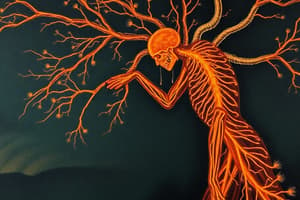Podcast
Questions and Answers
Define childhood and explain the difference between growth and development.
Define childhood and explain the difference between growth and development.
Childhood refers to the early stage of life from birth to adolescence, during which significant physical, emotional, and cognitive changes occur. It is a critical period where children learn fundamental skills, develop personalities, and grow through social interactions. Childhood is usually divided into two stages: early childhood (0-6 years) and later childhood (7-12 years). Growth refers to the quantitative changes in an individual's physical body, such as increases in height, weight, and size. It is purely physical and can be measured in numbers, such as weight in kilograms or height in centimeters. Development, on the other hand, is a broader concept that includes both quantitative and qualitative changes. It covers cognitive, emotional, social, and moral progress. For example, language development, emotional intelligence, problem-solving abilities, and social skills all fall under development. Unlike growth, development is multidimensional and is not restricted to physical aspects alone.
Which of the following are principles of growth and development? (Select all that apply)
Which of the following are principles of growth and development? (Select all that apply)
- Different areas of development are interrelated. (correct)
- Rate of development varies. (correct)
- Development is unpredictable.
- Development follows a predictable pattern. (correct)
- Development is continuous. (correct)
- Early development is crucial. (correct)
What are the stages of development in childhood? Discuss physical, emotional, cognitive, and social development.
What are the stages of development in childhood? Discuss physical, emotional, cognitive, and social development.
The stages of development in childhood include physical, emotional, cognitive, and social dimensions, which occur concurrently but at varying rates: Physical Development: Involves changes in body size, appearance, motor skills, and physical coordination. For example, during early childhood, children learn to walk, run, and develop fine motor skills like writing or tying shoes. Emotional Development: Refers to the ability to understand and express emotions. Children learn to regulate their emotions, recognize others' feelings, and develop self-esteem. For example, during later childhood, children become more adept at managing frustration and expressing themselves. Cognitive Development: Cognitive development involves the growth of thinking, reasoning, problem-solving, and decision-making abilities. Jean Piaget's theory of cognitive development identifies stages such as the preoperational (2-7 years) and concrete operational (7-11 years), where children learn to use symbols and think logically. Social Development: This aspect involves learning to interact with others, form relationships, and develop social norms. Friendships, teamwork, and learning to communicate effectively with peers are crucial parts of social development. For example, children often play games that involve cooperation, which teaches them social rules and roles.
Explain the factors that influence childhood development.
Explain the factors that influence childhood development.
Describe Piaget's theory of cognitive development and its stages in childhood.
Describe Piaget's theory of cognitive development and its stages in childhood.
Discuss the role of the family and peers in the socialization process during childhood.
Discuss the role of the family and peers in the socialization process during childhood.
Discuss the role of family in influencing childhood development.
Discuss the role of family in influencing childhood development.
Explain how peer relationships influence childhood development.
Explain how peer relationships influence childhood development.
Discuss the stages of physical, mental, emotional, social, and moral development in children.
Discuss the stages of physical, mental, emotional, social, and moral development in children.
Describe the principles of growth and development.
Describe the principles of growth and development.
How do schools and teachers influence childhood development?
How do schools and teachers influence childhood development?
Flashcards
Childhood
Childhood
The period from birth to adolescence, characterized by rapid growth and significant changes in physical, cognitive, social, and emotional abilities.
Growth
Growth
Physical changes like increase in height, weight, and body size.
Development
Development
The overall process of becoming more mature and complex, including physical, cognitive, social, and emotional changes.
Development is Continuous
Development is Continuous
Signup and view all the flashcards
Development Follows a Pattern
Development Follows a Pattern
Signup and view all the flashcards
Rate of Development Varies
Rate of Development Varies
Signup and view all the flashcards
Different Areas of Development are Interrelated
Different Areas of Development are Interrelated
Signup and view all the flashcards
Development is Predictable
Development is Predictable
Signup and view all the flashcards
Early Development is Crucial
Early Development is Crucial
Signup and view all the flashcards
Physical Development
Physical Development
Signup and view all the flashcards
Mental/Cognitive Development
Mental/Cognitive Development
Signup and view all the flashcards
Emotional Development
Emotional Development
Signup and view all the flashcards
Social Development
Social Development
Signup and view all the flashcards
Moral Development
Moral Development
Signup and view all the flashcards
Family
Family
Signup and view all the flashcards
Peers
Peers
Signup and view all the flashcards
Neighborhood
Neighborhood
Signup and view all the flashcards
School
School
Signup and view all the flashcards
Community
Community
Signup and view all the flashcards
Piaget's Cognitive Development Theory
Piaget's Cognitive Development Theory
Signup and view all the flashcards
Erikson's Psychosocial Development Theory
Erikson's Psychosocial Development Theory
Signup and view all the flashcards
Vygotsky's Sociocultural Theory
Vygotsky's Sociocultural Theory
Signup and view all the flashcards
Kohlberg's Moral Development Theory
Kohlberg's Moral Development Theory
Signup and view all the flashcards
Sensorimotor Stage
Sensorimotor Stage
Signup and view all the flashcards
Preoperational Stage
Preoperational Stage
Signup and view all the flashcards
Concrete Operational Stage
Concrete Operational Stage
Signup and view all the flashcards
Formal Operational Stage
Formal Operational Stage
Signup and view all the flashcards
Socialization
Socialization
Signup and view all the flashcards
Parenting Styles
Parenting Styles
Signup and view all the flashcards
Social Learning Theory
Social Learning Theory
Signup and view all the flashcards
Zone of Proximal Development
Zone of Proximal Development
Signup and view all the flashcards
Pre-Conventional and Conventional Morality
Pre-Conventional and Conventional Morality
Signup and view all the flashcards
Post-Conventional Morality
Post-Conventional Morality
Signup and view all the flashcards
Study Notes
Course 1: Childhood and Growing Up
-
Unit 1: Introduction to Childhood
- Meaning and definition of childhood, growth, and development
- Principles of growth and development
- Stages of development (physical, mental, emotional, social, and moral)
- Factors influencing childhood (family, peers, neighbors, school, and community)
- Theories of development
-
Unit 2: Understanding Adolescence
- Who is an adolescent?
- Chief characteristics of adolescents
- Pattern of growth and development in adolescents
- Common difficulties of adolescents and solutions
- Roles and responsibilities (teacher, family, community)
-
Unit 3: Intelligence and Personality
- Meaning, nature, and types of intelligence
- Theories of intelligence
- Measurement of intelligence (IQ)
- Personality (meaning, nature, theories, and determinants)
-
Unit 4: Language Development
- Concept of language development
- Development of language and speech
- Factors affecting language development at different stages
- Speech difficulties and disorders among students
- Bilingual and multilingual children (educational implications)
-
Unit 5: Understanding Individuals and Socialization
- Concept of individual differences
- Factors affecting individual differences
- Types of individual differences
- Educational implications of individual differences (organizing educational activities)
- Concepts of social diversities and socialization
- Individual differences among children (socio-cultural and economic context)
- Process of socialization
- Relationships with peers (friendships, gender, competition, cooperation, conflict, aggression, and bullying)
-
Mode of Transaction
- Classroom discussions (developing conceptual understanding)
- Close reading of text materials/research papers
- Individual and group presentations
- Theoretical and practical activities (exercises, investigations, analysis, and interpretation of collated observations and systematic data)
-
Reference Books
- Includes authors, book titles, and general information given for each book noted
-
Unit 1 (Continued): Introduction to Childhood
- Meaning and definition of childhood
- Growth
- Development including various aspects
- Principles of growth and development
- Stages of development
- Factors influencing development
- Theories of development
-
Stages of Development:
- Physical development
- Mental/cognitive development
- Emotional development
- Social development
- Moral development
-
Factors Influencing Childhood Development
- Family
- Peers
- Neighborhood
- School
-
Theories of Development
- Jean Piaget's Cognitive Development Theory
- Erik Erikson's Psychosocial Development Theory
- Vygotsky's Sociocultural Theory
- Kohlberg's Moral Development Theory
-
How to use knowledge for exams
- Definitions and concepts
- Principles of growth and development
- Stages of development
- Factors influencing childhood development
- Theories of development
-
Questions for Practice
- Questions and answers on childhood, growth, and development
Studying That Suits You
Use AI to generate personalized quizzes and flashcards to suit your learning preferences.




